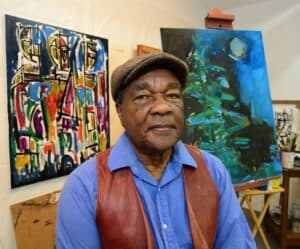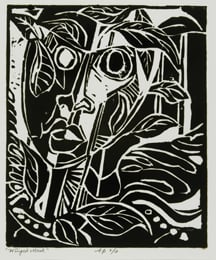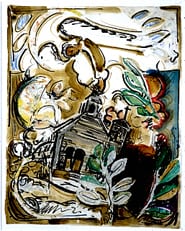For more than a century African American visual artists have created images and told stories that have chronicled the history of blacks in America, reflected and defined black American identity, and been a platform for social and cultural awareness. Arguably, no one has had a more central role in this story over the past 60 years than David C. Driskell. A professor of art and art history, a curator and a practicing artist, Driskell’s mission has been to bring African American art to Americans from all walks of life. His dedication to making sure art by African Americans is appreciated for its defining role in our society has made him one of the most important cultural figures of the past half century.
 As a mentor to me and dozens of artists, art historians, collectors, students and more, Driskell brought his personal touch to teaching, curating, collecting and writing. After he retired in 1998 as a Distinguished University Professor at the University of Maryland, Driskell flourished as an artist exploring color, nature, family, religion and the power of African ancestry. Dr. Driskell passed away peacefully in April 2020.
As a mentor to me and dozens of artists, art historians, collectors, students and more, Driskell brought his personal touch to teaching, curating, collecting and writing. After he retired in 1998 as a Distinguished University Professor at the University of Maryland, Driskell flourished as an artist exploring color, nature, family, religion and the power of African ancestry. Dr. Driskell passed away peacefully in April 2020.
Born an artist
Born in Eatonton, Georgia in 1931, Driskell’s creative spirit was recognized early in his life. He eventually went to Howard University where he studied art and art history and became associated with the major figures in the field such as James A. Porter and Lois Mailou Jones. While building a career as a professor of art and art history at major universities such as Fisk University, Howard University and The University of Maryland, Driskell continuously nurtured his own artistry and has become an artist of renown in his own right. One interesting aspect of his work over the years has been his dedication to representing his family, both immediate and ancestral.
Family Spirit
Since the Harlem Renaissance, black artists have been exploring the links between Africa and African Americans. Driskell, after his 1969 trip to Nigeria, began creating works that were inspired by the spiritual connection he felt to his African ancestry. He began incorporating African masks into his paintings, prints and collages. Winged Mask, a woodcut print from 1999 is a good example of the way Driskell fuses the human face with the mask while introducing leaves and patterns for a decorative effect. He based this work on a Dan mask from the Ivory Coast that he has in his personal collection. Driskell once told me that the mask-like faces found throughout his body of work represent the collective power of the ancestors who are always present in our lives.

Much of Driskell’s work is rooted in memories of his youth, his parents and family life growing up in North Carolina. Echoes: Let the Church Roll On, 1995-96, currently in the Bowdoin College Museum of Art, is a tribute to his father’s Baptist church and ministry and represents the family chapel watched over by a protective angel floating above. Again, Driskell incorporates lush foliage that recalls the North Carolina landscape as well as his lifelong devotion to gardening. Driskell’s creative reflections on memory and ancestry remind us of the importance of family and the spiritual connections through the generations that sustain our lives.

Driskell often said that for him art is a “priestly calling.” I think of David Driskell as an evangelist who traveled the world spreading the gospel of African American art, making the most of his “calling.”
Recommended Books on David Driskell
David C. Driskell Artist and Scholar by Julie L. McGee, Pomegranate, 2006
Evolution: Five Decades of Printmaking by David C. Driskell by Adrienne L. Childs, Pomegranate, 2007







Share your thoughts